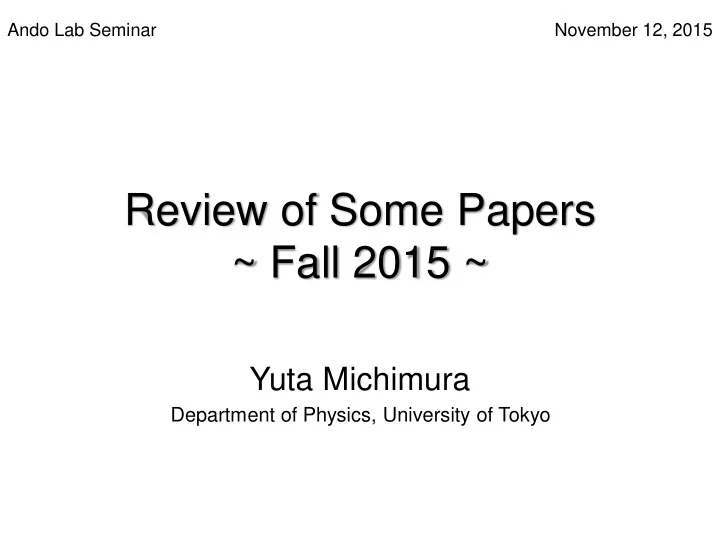

Ando Lab Seminar November 12, 2015 Review of Some Papers ~ Fall 2015 ~ Yuta Michimura Department of Physics, University of Tokyo
Papers to Review • B. Wojtsekhowski, arXiv:1509.02754 On a sidereal time variation of the Lorentz force • Y. Uesugi +, arXiv:1509.05840 Feedback-free optical cavity with self-resonating mechanism • S. R. Parker +, arXiv:1510.05775 Cross-correlation measurement techniques for cavity-based axion and weakly interacting slim particle searches • Y. Inoue, K. Ishidoshiro, arXiv:1509.08270 Hidden photon measurements using the long-baseline cavity of laser interferometric gravitational-wave detector 2
Anisotropy Search by Cyclotron • B. Wojtsekhowski, arXiv:1509.02754 On a sidereal time variation of the Lorentz force • test the isotropy of the “maximum speed” of electrons/positrons (CPT test; not LI test) • projected limit on one-way anisotropy: 1e-18 (current limit: dc/c < ~1e-15 (from out experiment)) 3
Method • static magnetic field • modified dispersion equation leads to modified Lorentz force → modified beam trajectory preferred direction model parameter • measure momenta in opposite directions (p + and p - ) • electron beam and positron beam in opposite directions (p e + , p e - , p p + , p p - ) → cancellation of sidereal drift • pretty clever same figure also in 4 B. Wojtsekhowski, Europhysics Letters, 108 , 31001 (2014)
Questions • anisotropy in the maximum attainable speed of electrons/positrons • anisotropy in the speed of light (photons) Are these two the same?? • maybe not; the former is CPT violation, the latter is Lorentz violation • formulation needed for implications of this experiment 5
Self-Resonating Cavity • Y. Uesugi +, arXiv:1509.05840 Feedback-free optical cavity with self-resonating mechanism • demonstration of high finesse (4.65e5) cavity without active feedback 6
By the way: Authors • high energy lab at Hiroshima University http://www.huhep.org/ • self-resonating cavity was developed for laser-Compton photon sources weak from laser-Compton source measurement the author ! make • this group also does x-rays gamma rays weak measurement 7
Setup • cavity mirrors from ATF, R > 99.999% guaranteed • PBS/QWPs to prevent backward scattering • much like laser oscillation wavelength division multiplexer Yb-doped single mode fiber (peak at 1030 nm) 978 nm 330 mW super invar 1047 nm L = 208 mm incident: 13.5 mW trans: 4.76 mW Pcav = 5.52 kW 8
Questions • difference between usual laser? gain medium will get damaged with high intra-cavity power • what was the finesse? - 646000 ± 3000 from ring down measurement (at 1064 nm) - 465000 ± 3000 from transfer function measurement (linewidth 1.5 kHz) - linewidth was 1.1 THz (2 nm) from laser spectrum 9
Maximum Stored Power to Date • Current maximum: 670 kW (average power of pluses) H. Carstens +, Optics Letters 39 , 2595 (2014) • Advanced LIGO: 745 kW (finesse 450) • Advanced Virgo: 650 kW (finesse 450) • KAGRA: 410 kW (finesse 1530) 10 • Einstein Telescope HF: 3 MW (finesse ~900?)
WISP Search Using Cavities • S. R. Parker +, arXiv:1510.05775 Cross-correlation measurement techniques for cavity-based axion and weakly interacting slim particle searches • WISPs are dark matter candidates 11
Previous WISP Searches • WISP: weakly interacting slim particle (sub-eV mass) - axion axion-photon conversion under magnetic field - hidden sector photon mixing analogous to neutrino flavor • WISP searches - haloscope - light shining through a wall (LSW) http://www.icepp.s.u-tokyo.ac.jp/ ~minowa/Minowa_Group.htm https://alps.desy.de/e191931/ 12
Dark Matter Halo • to explain galaxy rotation curve • observed speed of rotation is faster than prediction from stellar mass and gas • due to dark matter (or modification of gravitational law) ? https://en.wikipedia.org/wiki/Dark_matter_halo predicted observed 13 http://pages.uoregon.edu/jimbrau/astr123/Notes/Chapter23.html
Haloscope • inverse Primakoff effect axions → microwave photons (under magnetic field) • S. J. Asztalos +, Phys. Rev. Lett. 104 , 041301 (2010) SQUID-Based Microwave Cavity Search for Dark-Matter Axions Cu-plated microwave cavity (tune resonant freq. with rod; 500 MHz to 1 GHz) 7.6 T mixed down for sampling axions from halo • limited by thermal noise + first amp noise 14
Cross-Correlation • reduce uncorrelated noise typically 20 - 30 dB • nothing new reduction of first amp noise (can also be used for better characterization of the cavity; e.g. Q-factor) reduction of cavity thermal noise - axion signal remains if cavities are close enough (<10-100 m; de Broglie wavelength of the axion) - can be used to measure coherence length - have to tune resonant freqs 15
Hidden Photon Using GW Detector • Y. Inoue, K. Ishidoshiro, arXiv:1509.08270 Hidden photon measurements using the long-baseline cavity of laser interferometric gravitational-wave detector • can reach hidden Higgs, cold dark matter region 16
LSW with GW Detector • light shining through a wall • TES bolometer can be placed outside the mountain transition edge sensor 17
Sensitivity How do we align and • larger the better, higher power the better mode-match • more number of reflections the better re-generation cavity? • further sensitivity increase with re-generation cavity 1 year obs. re-generation length 1000 m no re-generation cavity 18
Comparison with Previous • can reach hidden Higgs, cold dark matter region with re-generation cavity PRL 111 , 041302 (2013) PRD 88 , 075014 (2013) 19
Summary • cavities are interesting 20
Recommend
More recommend